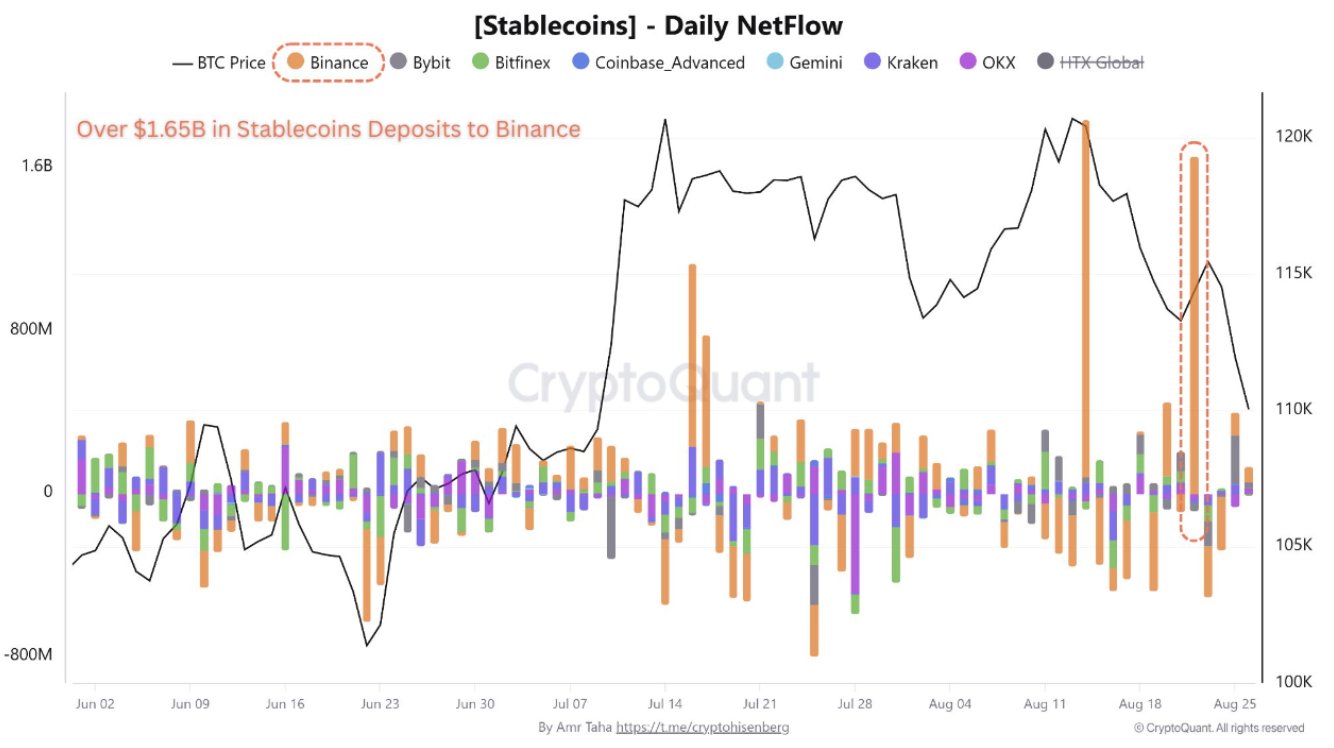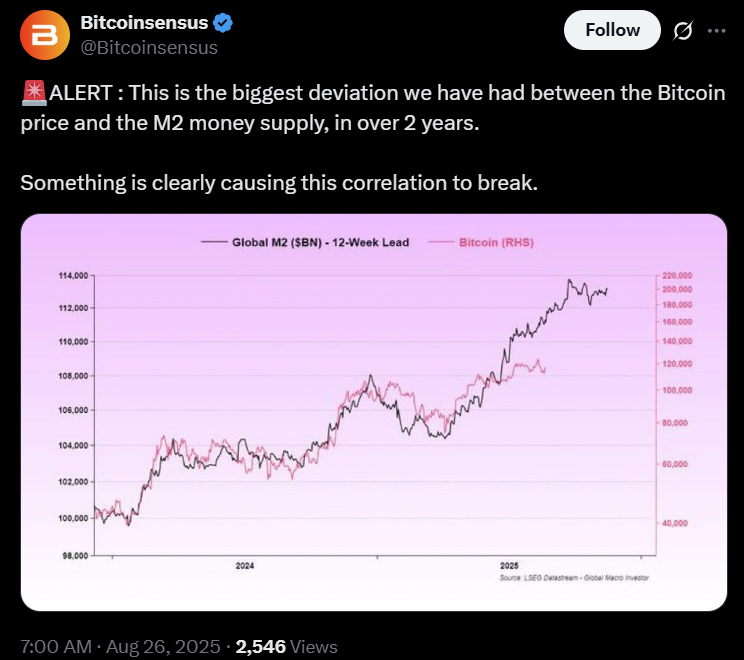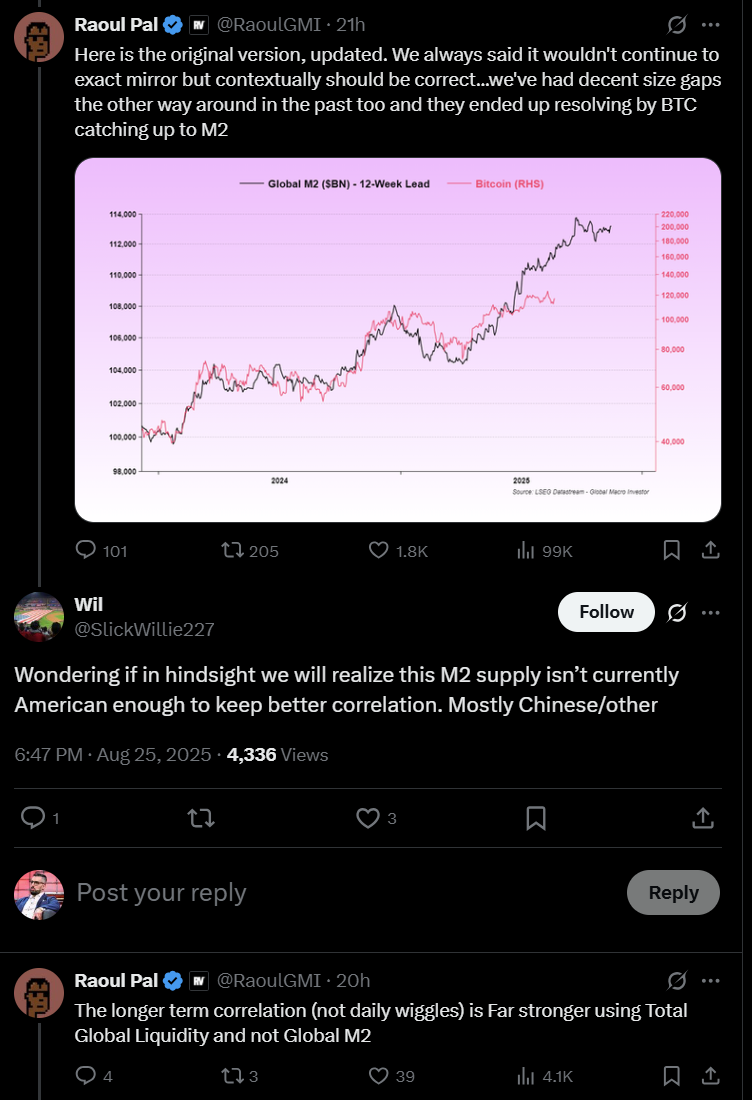Binance stablecoin inflows of $1.65 billion signal renewed spot-market buying potential while Bitcoin’s sub-$110,000 volatility reflects whale-driven selling and heavy liquidations; traders should watch exchange stablecoin balances and ETF flows for near-term directional cues.
-
Binance stablecoin inflows reached $1.65B, often a precursor to spot buying
-
Nearly $1B of Ether withdrawals from Binance occurred at the same time, indicating asset reallocation.
-
Bitcoin briefly dipped under $109,000 after a 24,000 BTC whale sell-off and substantial long liquidations.
Binance stablecoin inflows spike to $1.65B, signaling possible spot-market demand and BTC volatility; read analysis and key takeaways for traders.
Massive stablecoin deposits highlight shifting capital flows on Binance, even as Bitcoin whipsawed below $110,000 amid whale-driven selling and heavy liquidations.
Users of the Binance cryptocurrency exchange deposited $1.65 billion in stablecoins in a single session — a sizable inflow that market participants often interpret as dry powder ready to enter the spot market.
The deposit coincided with nearly $1 billion in Ether (ETH) withdrawals from Binance, according to on-chain analytics provider CryptoQuant. CryptoQuant’s Amr Taha described the move as “underscoring a renewed wave of capital entering the spot market.” This was the second time this month net stablecoin deposits on the exchange exceeded $1.5 billion.

Stablecoin net daily inflows into Binance have spiked recently. Source: CryptoQuant
Binance, the world’s largest cryptocurrency exchange by trading volume, processed more than $29.5 billion in trades on Tuesday — roughly six times the volume reported for the runner-up exchange, per CoinMarketCap data in market reports. Stablecoins remain the primary funding vehicle for traders, and their movement onto exchanges frequently precedes buy-side activity.
What are Binance stablecoin inflows telling traders?
Binance stablecoin inflows indicate increased buying capacity on the exchange and can precede spot-price appreciation. Large inflows often mean traders are preparing to convert stablecoins into BTC, ETH or other spot assets, making on-chain stablecoin balances a leading indicator for short-term demand.
Timing matters: when inflows align with price pullbacks or ETF inflows/outflows, they help frame likely near-term market direction.
How did Bitcoin react to the whale sell-off and liquidations?
Bitcoin experienced sharp downside movement after a whale moved 24,000 BTC over the weekend, triggering a cascade of long liquidations. The BTC price briefly dipped below $109,000 on Tuesday, fueling further volatility. TradingView price feeds showed a snapback to just above $111,000 later in the session as buyers absorbed selling pressure.
Liquidation events amplified volatility because forced sales hit leveraged positions, reducing depth in order books and creating outsized intraday moves.

Bitcoin’s price was last seen trading above $111,000. Source: TradingView
Why does the Bitcoin–M2 divergence matter now?
Bitcoin’s early-week slump produced the largest divergence in two years from its historical correlation with global M2 money supply. Since the pandemic, BTC often tracked global M2 with a two- to three-month lag, giving traders a macro lens for short-term trends.
As Real Vision founder Raoul Pal has noted, longer-term correlations are stronger when measuring total global liquidity rather than M2 alone. That distinction matters to macro-driven investors assessing risk premia across asset classes.

Source: Bitcoinsensus
Another volatility driver has been steady outflows from US spot Bitcoin ETFs. CoinShares reported Bitcoin ETF outflows exceeding $1 billion last week, though the products recorded their first day of net inflows in six sessions on Monday. ETF flow data and exchange stablecoin balances together provide a clearer short-term picture of supply and demand.

Source: Raoul Pal
Related: Bitcoin late longs wiped out as sub-$110K BTC price calls grow louder
Magazine: Stablecoins in Japan and China, India mulls crypto tax changes: Asia Express
Frequently Asked Questions
Will Binance stablecoin inflows push BTC and ETH higher soon?
Large stablecoin inflows increase the probability of buy-side pressure, but price direction depends on net flows, liquidity, and concurrent selling. Combine inflow metrics with ETF flow and order-book data to assess timing.
How do traders use on-chain analytics for exchange flows?
Traders monitor deposit/withdrawal trends, stablecoin balances, and large transfers to anticipate demand shifts. On-chain analytics providers and market-volume reports are common sources of that data.
Key Takeaways
- Stablecoin inflow spike: $1.65B deposited to Binance signals increased buying capacity.
- Concurrent ETH withdrawals: Nearly $1B left Binance, suggesting asset reallocation or custody shifts.
- BTC volatility driver: A 24,000 BTC whale sale and long liquidations pushed BTC below $109K, emphasizing risk.
Conclusion
Large Binance stablecoin inflows combined with significant ETH withdrawals and ETF flow swings point to intensified capital rotation and short-term market sensitivity. Traders should monitor exchange flow data, liquidation indicators, and ETF reports to refine entries and risk management. For ongoing updates, follow COINOTAG coverage and on-chain analytics reports.
